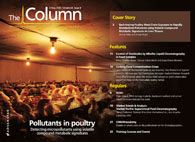DNA damage
A group of researchers in the USA has carried out an investigation using both gas chromatography-mass spectrometry (GC?MS) and inductively coupled plasma mass spectrometry (ICP?MS) to reveal that engineered nanoparticles can accumulate within plants and damage their DNA.

A group of researchers in the USA has carried out an investigation using both gas chromatography-mass spectrometry (GC–MS) and inductively coupled plasma mass spectrometry (ICP–MS) to reveal that engineered nanoparticles can accumulate within plants and damage their DNA.1 These engineered nanoparticles are found in many commercial products and are often released into the environment. In the past it has been shown that metal‑based nanomaterials act as mediators of DNA damage in mammalian cells and organisms, but for the first time copper oxide nanoparticles have been revealed to induce DNA damage in agricultural and grassland plants.
The tests were performed on radish (Raphanus sativus), perennial ryegrass (Lolium perenne) and annual ryegrass (Lolium rigidum). GC–MS detected base lesions and ICP–MS measured copper uptake. There was significant accumulation of oxidatively modified, mutagenic DNA lesions and plant growth inhibition was observed. The lesion levels were measured in tandem to clarify the mechanisms of DNA damage.
The group concluded that they had produced the first evidence of multiple DNA lesion formation in plants and that this provided the basis for further research.
1. Bryant C. Nelson et al.,
Environmental Science and Technology
,
46
(3), 1819–1827 (2012).
This story originally appeared in The Column. Click here to view that issue.

New TRC Facility Accelerates Innovation and Delivery
April 25th 2025We’ve expanded our capabilities with a state-of-the-art, 200,000 sq ft TRC facility in Toronto, completed in 2024 and staffed by over 100 PhD- and MSc-level scientists. This investment enables the development of more innovative compounds, a broader catalogue and custom offering, and streamlined operations for faster delivery. • Our extensive range of over 100,000 high-quality research chemicals—including APIs, metabolites, and impurities in both native and stable isotope-labelled forms—provides essential tools for uncovering molecular disease mechanisms and exploring new opportunities for therapeutic intervention.
New Guide: Characterising Impurity Standards – What Defines “Good Enough?”
April 25th 2025Impurity reference standards (IRSs) are essential for accurately identifying and quantifying impurities in pharmaceutical development and manufacturing. Yet, with limited regulatory guidance on how much characterisation is truly required for different applications, selecting the right standard can be challenging. To help, LGC has developed a new interactive multimedia guide, packed with expert insights to support your decision-making and give you greater confidence when choosing the right IRS for your specific needs.

.png&w=3840&q=75)

.png&w=3840&q=75)



.png&w=3840&q=75)



.png&w=3840&q=75)










